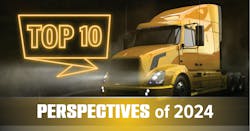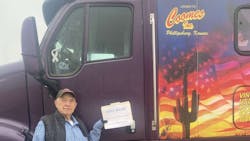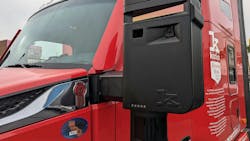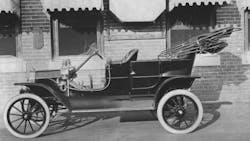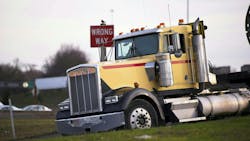Throughout 2024, FleetOwner editors and contributors shared our perspectives on the complex trucking, transportation, and freight industries, sharing our views and based on our travels and reporting—and looking to give a voice to the smaller fleets and operations that fuel the industry and U.S. economy.
Here is a look back at some of the FleetOwner Perspective pieces that drew the most attention and responses from readers in 2024.
10. A high-def history reminder as we focus on the future
Any time I get a chance to drive an electric truck or talk to a fleet leader about the challenges ahead for this transportation transformation our industry is experiencing, I think of HDTVs.
The first time I saw a high-definition TV in person, I was a poor college student looking for a new television at a Nobody Beats the Wiz electronics store in the late 1990s. The flat screen displayed a football game with such detail that I could count the grass blades. The future was in high-definition, but I was bound to walk out of the New York store that day lugging a heavy box TV. The new technology was amazing—but too expensive for a guy who thought getting dinner at Wendy’s was splurging.
Fleet leaders looking at new, high-tech electric and alt-fuel trucks might feel like I did while looking at those high-tech TVs 25 years ago: It’s a fantastic technology, but I don’t see how it could fit into my life today. I am not sure if all fleet leaders and truck drivers will feel the same way about EVs, fuel cells, and internal combustion engines running on renewable fuels 10 or 20 years from now. But it’s almost assured that these new transportation technologies are bound to get cheaper and more accessible. After all, the greenhouse gas-reduction technology loaded into newer heavy-duty trucks is getting more expensive to produce and more complex to maintain. Read more…
9. Cannabis competition creates carrier conundrum
For years, after crossing into Michigan from Ohio on Interstate 75, drivers would be overwhelmed with billboards touting god, guns, beef jerky—and, if you’re injured, telling you to call Joumana. But in the years since Michigan legalized recreational marijuana, most of those billboards dotting the farmlands between Toledo and Detroit are ads for rival marijuana dispensaries.
Since Michigan began permitting recreational weed sales in 2019, legalization has spread across northern states. More than half of the 23 states allowing recreational sales made it legal this decade. (Another 13 states permit medical marijuana.) Michigan recently overtook California as the largest cannabis market in the U.S. The legalization movement is winning—state by state.
“In 2023, 41% of drivers in the United States lived in a state where recreational marijuana was legal,” Jeffrey Short, VP at the American Transportation Research Institute, told FleetOwner Editor Jeremy Wolfe for this week’s feature on trucking’s marijuana problem. “In 2019, it was half that number. It’s quite a big jump to all of a sudden happen.” Read more…
8. Fleets Explained: How the trucking industry works
When you’re new to this industry, things can feel overwhelming quickly. Even those of us who have been in and around trucking for several years can learn something new about transportation. With all the new technologies and power systems, I bet even some real trucking old-timers are still learning a thing or two.
I am no old-timer, but I've been around long enough to lose count of how many times I’ve met someone at industry events who just joined a fleet or supplier staff and was trying to immerse themselves in as much as they could learn at workshops, expo halls, and cocktail hours. Learning about trucking and fleet management is like drinking from a firehose: You’ll pick up a lot of information with each gulp, but you know you can’t catch it all.
For the new industry members and those of us who are still learning and refining our transportation knowledge, we launched a new series at FleetOwner.com: Fleets Explained, where we’ll break down standard trucking industry terms, concepts, history, and more. Read more…
7. Five Good Things: Truck driver role models
I’m always amazed by the things truck drivers do on a daily basis, but this week, a few drivers pulled off brave, extraordinary feats.
Two truck drivers save the day, Guinness World Records honors oldest truck driver, ATA rewards Trucking Moves America Forward leaders, and more in this FleetOwner Five Good Things installment from 2024. Read more….
6. CES 2024: The future is almost here for latest truck technology
LAS VEGAS—More trucks and trucking technology might be displayed here at the Consumer Electronic Show than ever before. While trucking is still a small subset of the thousands of exhibitors who’ve descended upon this desert oasis, you can’t miss the growing commercial vehicle presence here.
With a big focus on autonomous driving, Kodiak Robotics, Aurora Innovation, Torc Robotics, and Gatik AI all came to CES 2024, along with up to 300,000 attendees, to show off new developments and partnerships at the Las Vegas Convention Center and up and down the Vegas Strip.
A lot of these companies’ technologies appeared more theoretical years ago. But the future is almost here, according to the people behind some of the most innovative freight equipment ever seen. Read more…
5. Another EV obstacle: Tires
A few short years ago, the buzz around a Class 8 electric vehicle manufacturer was impossible to ignore. It was a masterclass in marketing and promotion that culminated in the founder's conviction in December 2023 for deceiving investors. Everyone was so happy to hear that electric trucks were on the market that they wanted to believe everything he said. A jury determined he was less than truthful in his claims, which defrauded investors of more than $660 million.
Electric trucks are here in tiny numbers, and a few fleets have operational success. Like their passenger vehicle counterparts, the rate of tire wear is accelerated, so it must be factored in when determining the total cost of operation. With fewer than 1,000 over-the-road heavy-duty EVs, fleets are still in the data-collecting stage, but tread mileage will be an unavoidable trade-off.
Tire manufacturers are in various stages of supplying tires for electric trucks and buses. There will undoubtedly be some construction, rubber compound, and/or tread design changes to account for the additional torque and weight. The small number of electric trucks is creating data to help shape the first generation of EV truck tires. Still, the applications are limited, so the data is limited. Read more…
4. Volvo sees fleet profitability paved upon its path to zero
GOTHENBURG, Sweden—The uncertain future of transportation isn’t just about what power systems will prevail; it’s about how fleets will make money with emerging yet unproven technologies. But after spending a week here, it’s apparent that Volvo Trucks believes the future of trucking profitability is green—because the world and the next generation are demanding it.
The OEM, which hosted North American transportation journalists here on Sweden’s western coast, showed how the company is creating a cleaner and safer future for trucking and is determined to successfully convert its 1.2 million trucks operating worldwide to carbon-neutral, or net-zero, equipment by 2040.
Volvo Trucks President Roger Alm said it is vital to move to net-zero, which the global parent of Volvo Trucks North America and Mack Trucks began in 2019. “Because if you are not all moving to this situation on net-zero, we will not have this fantastic weather that we are having today, we will not have this world that we are living in today,” Alm said while looking out on a bright, sunny Gothenburg sky from a top-floor conference room at the new World of Volvo building. Read more…
3. The road to becoming an OEM
Walk onto nearly any automotive or trucking trade show floor and you’ll see at least one, if not several, new electric vehicle startups and the concept or prototype of their vehicle. It’s become a theme at industry trade shows year after year.
While it’s exciting to see what some of the brightest brains in the industry can come up with, it’s hard to know which to take seriously. After all, there’s no way of knowing which of these new brands will actually bring a vehicle to production–or which ones will make it to production and then come to a screeching halt. (We’re looking at you, Lordstown Motors and Fisker.)
FleetOwner affiliate publication IndustryWeek keeps a tab on multiple new EV startups with a Hot or Not list, rating these startups from Hot, OK, Mixed, and Not. The publication ranks these startups on aspects such as “production/delivery goals, financials, major news/deals, and the outlook for its potential to perform better.” IndustryWeek releases a new Hot or Not list each quarter, and it’s interesting to see how quickly the status of these startups can change.
It begs the question: What does it take to go from a startup to an OEM? Read more…
2. A half-billion-dollar nuclear verdict hits underrides: What's next?
How safe is safe enough? Trucking and federal regulators have worked for decades to find an achievable policy balance that serves the public while also allowing businesses to develop and grow. But so-called “nuclear verdicts” are putting a thumb on the scale to benefit a certain sort of attorney and at the expense of about everyone else.
The latest case in point: A St. Louis jury returned a $462 million verdict on September 5, with $450 million designated as punitive damages, in a lawsuit claiming Wabash National should have built a better rear impact guard 20 years ago.
I’m filing this as a FleetOwner Perspective piece because this is a story that demands a lot of answers I don’t immediately have: What will this mean for fleets still operating older trailers (or trailers with RIGs spec’d to meet NHTSA standards when stronger upgrades are available)? What will it mean for trailer OEMs that might wonder: What’s the point of federal safety standards if a jury can come back in a decade or two and decide you should’ve done better? And that’s not even scratching the surface of the complicated issues that have created an environment where nine-figure nuclear verdicts are no longer surprising—and which are leading to unsustainable trucking insurance rates. Read more…
1. Forget the carrot. EPA uses stick.
If the Environmental Protection Agency aimed to create a hard-to-achieve regulation that makes trucking more expensive, it succeeded with GHG3. If regulators and the environmentally focused Biden Administration want to clean up the air, they need to work more closely with the men and women moving our goods across the country—not against them.
Federal regulators finalized Phase 3 of the lofty Greenhouse Gas Emissions Standards, known as GHG3, on March 29. These new rules push commercial vehicle manufacturers to build and sell more zero-emission equipment to fleets. The regulations envision a nationwide freight network supporting Class 8 EVs and hydrogen-powered trucks. It’s an exciting vision, but exciting doesn’t make it realistic.
Rather than letting truck OEMs and the free market lead us into decarbonization, the EPA is telling OEMs they must sell more zero-emission commercial vehicles between 2027 and 2032. Forget offering fleets a carrot to encourage them to improve freight’s carbon footprint. This stick approach whacks away any thoughts of reasonable timelines to build out alternative fuel infrastructure to support trucking, the backbone of the U.S. economy. Read more…
Along with these articles, FleetOwner publishes several popular annual features that garner attention throughout the trucking and transportation industries. These include our annual looks at the largest commercial transportation systems in the U.S., the FleetOwner 500: For-Hire and FleetOwner 500: Private Fleets.
Our annual profiles of women in the industry, Women in Transportation 2024, were published this summer. Each year, FleetOwner recognizes the transportation operations of private fleets with the FleetOwner Private Fleet of the Year award. This fall, we expanded and rebranded our annual New Models to the 2025 FleetOwner vehicle guide, our largest-ever look at the next generation of heavy-duty, medium-duty, light-duty, and alternative-powered trucks and vans.
We put a bow on the year with the 2024 Trucking by the Numbers feature, an info-graphical look at the facts and figures that make up the trucking and transportation industries. To view what's ahead for FleetOwner in the new year, please check out our 2025 Media Kit.
About the Author
Josh Fisher
Editor-in-Chief
Editor-in-Chief Josh Fisher has been with FleetOwner since 2017. He covers everything from modern fleet management to operational efficiency, artificial intelligence, autonomous trucking, alternative fuels and powertrains, regulations, and emerging transportation technology. Based in Maryland, he writes the Lane Shift Ahead column about the changing North American transportation landscape.
